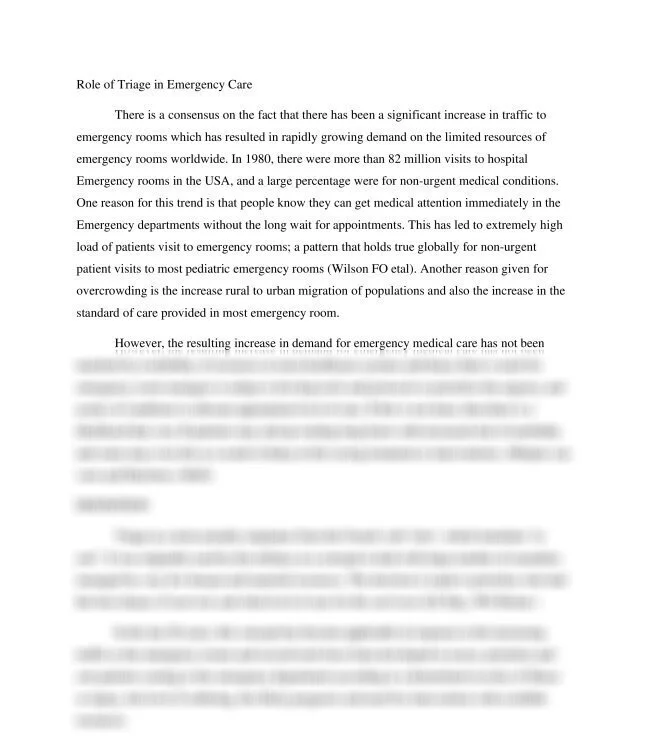Role of Triage in Emergency Care
Role of Triage in Emergency Care
( (2000) (Chang, (Christ (Dieckmann, (LE (Ma, (Mirjam (Murray (O’Neil (Pediatric (Travers (Wilson (risk (van ) 0 0.1-0.9 1 1, 120 15 1989, 1989.) 1996 1996) 19:285-290, 2 2, 20 2002). 2003) 2004, 2006). 2007 2009. 2010 2019, 3 3, 30 3:65-71, 4 4, 421-427.) 5 5-level 5. 60 6: 82 AE, ALREADY ATS Acad Acuity Another Australia: Australian(National Azeredo Bowling Bullard CEDIS CHILDREN CJEM CTAS CTAS, C]. Canadian Care Child Cohen’s College Coma D,) DA, DEFINITION Department E; ED ESI, Each Emerg Emergency FO Fittzgerald Flowers French GT. Gafni Gerber Glasgow Goldman) Gradstein Group. Group; Harriette Health. Hence However, Hsu) IN IS If In Index Intra It J; JM, Jones K K: KA, KNOWN? Laskowski-Jones Level M, MTS MTS, Manchester McNair Med Medicine. Molczan Moll Moll) Mortality National Observation One P, PRISM Pediatric Pediatric-CTAS Pediatrics Queensland, RD, Reliability Revisions Risk Rislan Role Royal Salati Scale Scale, Scale. Score, Severity Slay, So Some States States. Systems TRIAGE The There These This Though Trauma Triage UK UKs USA, USAs United University Validity Veen WG WHAT Waldrop Waller What When Where Whereas Working Yale Zimmerman [Fernandez [Laskowski-Jones]. a ability absolute absolutely according accurate actually acuity adaptations, adapted admissions admissions, adopt adult adults adults, adults’ affirmation after again age agree agreeing agreement agreement). agreement, aim aims al al) all allocate already also alter altering an analyzed anatomical, and another any applicable appointments. approach appropriate are area as assess, assessing assessment assignments. at attempts attention availability available baring based be became because become been best better between beyond both but by can capability care care, care. cases casualties chance chance, chance. channeling characteristics charts children children, children. clarified, classification classify clinic-pathological clinical collection, coming common complex comprehensive, concept conclusion conditions conditions. confirmed consensus consider considered contain creates creating criteria criteria. critical critical, criticized cultural data deal decision decisions defined delay demand department department, departments departments, described designed deterioration determination determine determined develop developed development diagnostic die differences different direct directly discriminated distinction do doctor doctoral done, driven due earlier effective efficient efficiently either elucidated emergency emergent, emergent–urgent–nonurgent emotional enables encounter end endorsed environmental equal equally established et etal). evaluated, even eventually every evidence evolved examined excellent experts experts.(Mackway-Jones external extremely fact factors fail far fast few first five five-level flow focused for found four from functional general get given globally group group. growing guidelines. had has have health healthcare help hence high highly his holds hospital hours human identify if ill illness illness, immediate immediately impact implementation important improved in inapplicable including incorporates increase increased increasing individuals influence initial injury injury, input institutions. intellectual intended inter internal intervention interventions. into invariably is it its itself k k. kappa know known lack large last later led legitimate length level levels life lifesaving likelihood likely limited load long longer low made major make makes making managed managers matched material may measurable measure measured measurement measures medical methodical methods migration military million minutes mixed modified morbidity more mortality mortality, most must necessity need needed needs no nomenclature non non-urgent non-urgent, none not note novo’ number nurse objective objectively obvious occasions. of on one optimize or originally originates other outcome outcomes outcomes. overcrowding pain parameters parameters. parts patient patients patients’ patient’s pattern pediatric pediatric-specific people per percentage perfect perform period personal physician. physiological physiological, pioneering poor populations possibility potential practice predict predicting predominantly predominated present presentation presentation. presented presenting priorities prioritize produce professionals. prognosis proof protocols provide provided provision quality question, rapid rapidly rate, rated rater raters rating reason reassessed recommended reduce referred relate reliability reliable reported reproducibility requiring resource resources resources. respiratory response result resulted resulting review revised risk room room. rooms rooms; rural same saving scale scale, scale. scales scales(Fitzgerald scales, scales. scales.(Cain scenario score score), scoring seem seen separate service services. setting. several severity severity). severity, should showed shown sickness significant similar simple simply six some sophistication sort sort’. specific specifically standard standardize standards statistically stay, stratification stratificaton strongly structured studied studies such sudden suffering, survival, survivors symptom symptoms system system, systematically systems targeted ten tend term than that the their them then there therefore these thesis they this thorough three-level tier, time times to tool tool. tools track. traffic translates treated treatment treatment, trend triage triage. triage: tried true two typically unacceptable underlying unique unit unreliable until up urban urgencies urgency urgency, urgent urgent, urgent. use used using utilization. utilizations valid validated validation validity validity. value van variations various veen verb very visit visits wait wait?’’ waiting wards was way well were what when which who widely with within without worldwide. years years, ‘be ‘de ‘little ‘to ‘trier’, ‘‘How
Role of Triage in Emergency Care
There is a consensus on the fact that there has been a significant increase in traffic to emergency rooms which has resulted in rapidly growing demand on the limited resources of emergency rooms worldwide. In 2019, there were more than 82 million visits to hospital Emergency rooms in the USA, and a large percentage were for non-urgent medical conditions. One reason for this trend is that people know they can get medical attention immediately in the
